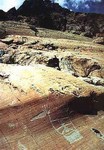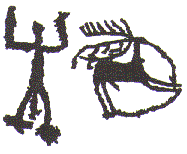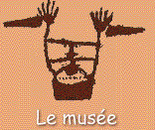Le Val decorated shelter
"La vallée des Merveilles"
Miracles Valley

To be able to compare the art of the Provençal rupestral paintings, and in particular the paintings of the cliff of Gueillet with the other rupestral representations, we are going to make here a summary presentation of the site of the Valley of the Miracles.
|
|
|
The Valley of the Miracles is in Alpes-Maritimes, near the valley of Roya and collar of Tende. It has a height of 2300 m and inherits from a hard climate where the legendary violence of the thunderstorms which burst out on the mountain Bego is doubtless connected to the nature of its soil rich in iron ore.

Of any time this valley seems to have impressed the local populations, and this fear, or this respect reappear in the toponymy of places: valley of the Miracles, the mountain Bego (the one who dominates), Valmasque ( Masca=witch), devil summit...
It nevertheless attracted curious and erudite, and from 1650, the historian of Nice Gioffredo mentioned for the first time the Valley of the Miracles. It will be necessary to wait for the years eighteen hundred and eighty so that a systematic study is begun by the botanist Clarence Bicknell who will identify more than eleven thousand carvings. At present, and since 1967, the researches are pursued every summer by a research team dependent of the laboratory of human paleontology and on prehistory of Marseille.
We count at present more than one hundred
thousand carvings distributed in the Valley of the Miracles and the Ciappa de
Fontanalba. These carvings were executed by piquetage of the cliff and appear in
rather clear green grey on the pink of the cliff. In the current state of the
researches, the place of the engraved cliffs seems to be randomly distributed.
As regards the very carvings, we can classify them in four groups of
iconographic subjects:
- Animals
- Weapons
- Human-like figures
- Geometric figures.
The group is essentially represented by horned figures which represent the great majority of the engravings. Their dimensions vary in the infinity, and some are even used as skeleton for more complex motives: the magician, the figure of Christ, certain pattern-like figures... It is about certain that these figures represent the bull and the ox in vertical projection; in this sense several harnesses representing these forms with an swing-plough are spread on the site. The sacred value of this sign, in agreement with the myth of the bull in the Mediterranean pond, is revealed by the big number of times when it is used, and by its association with very particular and unique human-like figures such the headman and the magician.
 |
 |
This group including carvings representing weapons (daggers, swords, halberds) and tools (forgery, sickles) is an extremely precious tool, and the only one which allow us to date the carvings. Indeed, by comparing carvings with the characteristic weapons of a given time, we can go back up to the model of the carving and so date this one.
 |
 |
We can distinguish in this group two subgroups constituted by the " small persons " and the "major figures". The small persons are the most numerous and seem either isolated in the position of the orant, or in connection with the other carvings as in the case of harnesses. Rarer and more often unique, major figures seem more complex and more significant, although their sense is still hidden from us. Their appearance is remarkable and their places seem to have carefully been chosen. We often find, as motives for skeleton or as associated motives for the horned figures which "make sacred" in a sense the represented subject.
 |
 |
 |
We classified in this category different figures of very different aspects and among which distinguish themselves the called figures "pattern-like figures". We shall note that there are, more low in the valley, enormous structures of low walls which call back the drawing of some pattern-like figures; we can suppose also that certain figures could be of use to the elaboration of a cadastre by representing fields, houses... Finally, we find signs the meaning of which is totally unknown to us in the context: circles, concentric circles, points, rectangles....
 |
 |
The dating of carvings, as we have already indicated it, is based on the study of weapons and represented tools. It seems about certain maintaining that the first carvings are executed at the beginning of the first Age of the Bronze, and that the cessation of the rupestral activity coincides with the Age of the final Bronze.
For memory:
Ancient Bronze age: 1800-1400 BC
Middle Bronze age: 1400-1200 BC
Final Bronze age: 1200-700 BC
They were late discovered (in 1973) in the high part of the valley of hell in a gias. We distinguish on a cliff, with a tourmented surface, three motives, among which two seem to represent a scene of hunting whereas the last one, a little aside, evokes a warrior. The naturalist type of the paintings and the use of the colour suggest a relative age and make them classify for the first period of the rupestral carvings (Enéolithique or first Age of the Bronze).
Much later carvings were discovered in the Valley of the Miracles; these carvings, said "shelf spaces" are discussed in another page of this site, to illustrate the site of the linear carvings of Gueillet.
| For more information on this site, click the icon: |
| A site so rich is in the North of Italy in the Valley Camonica; the wealth of the carvings which are there, whose big number represents scenes of the daily life, is a formidable tool to imagine itself the life at the beginning of the Age of the Bronze. |

| For more information on the Age of the Bronze in the region of Provence-Alpes-Côte-d'Azur, click the icon: |
Back
to "an attempt of interpretation": ![]()



